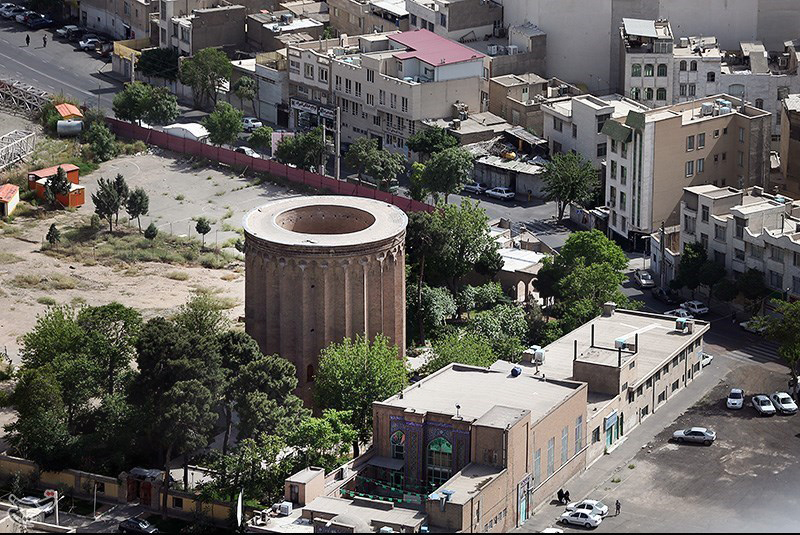Toghrol Tower is one of the prides of Medieval Iranian Architecture, located at the southern point of the capital, Tehran. It is one of the most neglected Tehran attractions by tourists and officials. The mysteries about the people buried there, the unclear duty of the Tower, and the still questionable overall shape of this building can keep you bewildered for a long time.
The Tower’s shape follows specific mathematical and geometrical rules that are still fascinating. Toghrol Tower is a 12th-century monument located in Rey, which is today part of Iran’s greater Tehran metropolitan area. The tower is a Seljuk-era construction and an important example of Persian architecture. It was originally built as a tomb, likely for Tughril Beg, the founder of the Seljuk Empire. Over time, however, the exact details of its construction and original purpose have become less clear.
Follow the Iran travel guide article on Toghrol Tower to get to know this mystic building.
Overlook of Toghrol Tower
Accessibility: To reach Toghrol Tower, you can get on Line 1 of the Tehran Metro (Red Line) and off at Share Rey station. From there, get into a bus and get off at Ibne Baviyeh Shrine.
Or get yourself to the Railway Square bus terminal. From there, get into a bus leading to Shahre Rey and get off at Imam Zadeh Abdollah.
Open days and hours: Toghrol Tower is open Thursdays to Sundays, from 8A.M to 5 P.M. (national celebrations might affect these hours)
Entrance fee: 150,000 RLS (2022)
Summary of Iranian Architecture, Toghrol Tower
Toghrol Tower is one of the few buildings left from the Seljuq Dynasty, 10th B.C. This Tower is located south of Tehran, in Rey County. Long before Tehran became the Capital, Rey was one the wealthiest and most thriving cities of the Silk Road at the heart of the Persian Empire. Toghrol Tower is the burial place of Toghrol Beik, one of the Seljug kings, and the Tower is named after him.

What was the Tower of Toghrul used for?
Toghrol Tower is 20 meters high and 12 meters in diameter. Unlike most of the towers, this one wasn’t designed for protection. The main purpose of this Tower was to direct travelers during the night by lighting a fire at the top of it.
Also, the architecture of this building is so precise and accurate that it could be used as a giant solar clock and tell you the exact time of the day. The exterior shape is that of a polygon with 24 angles. When the sun rises, it descends the most eastern jag. After 30 minutes, half of the second one is alight, and at the second hour, the second jag is alight, and so on. Finally, the sun will be at the top of the entrances at noon.
Another wonder of Iranian Architecture manifested in the Toghrol Tower is that people could determine the exact day of every month from the shadows cast by the jags of the Toghrol Tower.
Domeless Tower of Toghrol
What is interesting about this Tower is that the top of this building is open. Some believe that the dome has been destroyed as the years go by, but judging from the water drainage at the Tower’s center, some experts think the original design was domeless.
Toghrol Tower has been restored and reconstructed twice—the first during the Qajar era and the second during the 1990s. Unfortunately, the first time it was mended, most of the original brickwork and the original tablet, set at the top of the entrance and were manifests of Iranian architecture during the medieval time, were altered or removed.
What is visitors’ opinion about Toghrol Tower in Tehran?
Visitor opinions about Toghrol Tower may vary. Some visitors appreciate its historical significance, intricate brickwork, and importance in the context of Iranian history and Islamic architecture. Others may consider it somewhat plain, especially compared to other more elaborate Iranian landmarks, or find it less engaging due to the lack of extensive information or facilities available at the site.
Additionally, the area surrounding the tower is often noted for its peacefulness, providing a respite from the bustle of Tehran. However, the building has suffered neglect and environmental damage over the years, which can impact the visitor experience.
Tourists keen on history, architecture, or the Seljuk period may find Toghrol Tower especially interesting. At the same time, those looking for more visually striking or well-preserved sites might prefer other attractions.



No comment